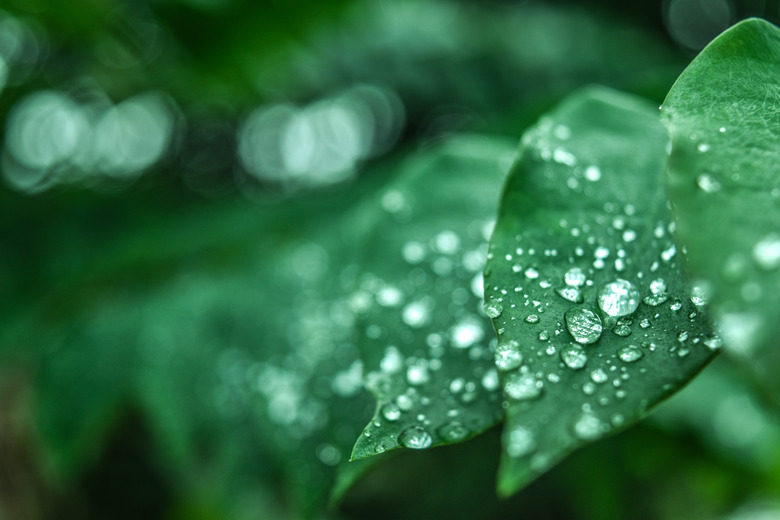Osmosis Facts For Kids
Osmosis is a simple natural process that occurs all around and inside us, and it's one on which our lives depend. The process is this: In a solution, molecules of a solvent, such as water, migrate across a barrier from the side containing a lower concentration of a particular solute (a minor component of the solution) to one containing a higher concentration of it, provided the barrier allows only the solvent molecules to pass. Osmosis requires no external force, and the reason why it occurs remained a mystery until the mid-20th century. According to the accepted explanation, osmosis occurs because the solvent molecules seek to distribute themselves equally on both sides of the barrier.
Plants Don't Drink Water – They Absorb It by Osmosis
Plants Don't Drink Water – They Absorb It by Osmosis
Every plant has roots, and the surface of every root is essentially a semipermeable barrier that allows water molecules to pass through. Most plant roots have hairs to increase the surface area of this membrane and maximize water intake. The roots also absorb any nutrients in the soil that are small enough to pass through the barrier along with the water.
Osmosis Creates Pressure
Osmosis Creates Pressure
If you fill a beaker with water, separate the beaker with a suitable semipermeable barrier and dissolve salt in one of the compartments, the water level in the compartment with the salt rises. This happens because osmotic pressure is greater than the pressure exerted on the surface of the water by the atmosphere. If you seal the container to prevent the water level from rising, osmotic pressure causes the membrane to swell in the direction of the side containing pure water.
You don't have to create an elaborate experiment to see osmotic pressure in action. Just drop a carrot into a glass of pure water and wait. When you check on the carrot in a day or two, you'll notice that it has swelled. You see the same swelling when you soak beans, nuts or rice in water.
The Cells of Our Bodies Absorb Water by Osmosis
The Cells of Our Bodies Absorb Water by Osmosis
Human beings drink water, but also their cells absorb it by osmosis in the same way that plant roots do. As the concentration of waste products in a cell rises, the osmotic pressure between the inside and outside of the cell wall – which is a semipermeable membrane – increases, and the cell absorbs water from the blood, which is a more dilute solution.
Have you ever wondered why you can't drink seawater? It's because adding salt to your blood increases the solute concentration and lowers the osmotic pressure at the cell walls. The cells can't absorb the water and become dehydrated. If you drank only seawater, you'd actually die of thirst!
Osmosis Is Important in Our Kidneys
Osmosis Is Important in Our Kidneys
It isn't just the cells of our bodies that rely on osmosis. Some organs, including the kidneys, also rely on it. The job of the kidneys is to filter waste products from the blood and eliminate them as urine. Each bean-shaped kidney contains more than a million microfilters called nephrons, which allow small particles, such as water, glucose, urea and ions, to pass through while excluding the blood molecules themselves. After this filtration takes place, the kidneys must reabsorb enough water to maintain a healthy balance in the blood plasma. They do this by osmosis. The human digestive system also relies on osmosis.
What Is Reverse Osmosis?
What Is Reverse Osmosis?
Pure water flows by itself through a porous barrier if the water on the other side contains impurities, but what about going the other way? It turns out that it is possible to force contaminated water through the same barrier by supplying enough pressure to overcome osmotic pressure. This idea, which is called reverse osmosis, is behind some of the most popular home water filtration systems.
Reverse osmosis has disadvantages when used for water filtration systems. It is slow, and it doesn't filter out dangerous contaminants that are as small as water molecules, such as chlorine, so it must be used in conjunction with a carbon filter. Moreover, it filters out some beneficial minerals, so if you have a reverse osmosis filter at home, it's a good idea to eat fruit, vegetables, greens and other foods high in minerals.
Cite This Article
MLA
Deziel, Chris. "Osmosis Facts For Kids" sciencing.com, https://www.sciencing.com/osmosis-kids-8650496/. 13 March 2018.
APA
Deziel, Chris. (2018, March 13). Osmosis Facts For Kids. sciencing.com. Retrieved from https://www.sciencing.com/osmosis-kids-8650496/
Chicago
Deziel, Chris. Osmosis Facts For Kids last modified March 24, 2022. https://www.sciencing.com/osmosis-kids-8650496/
